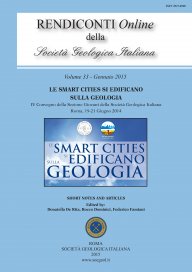
The importance of the geophysical methods for the determination of the urban subsurface structures
Klodian Skrame (*) & Michele Di Filippo (*)
(*) Department of Earth Sciences, Sapienza University of Rome, Piazzale Aldo Moro 5, 00185 Rome, Italy. E-mail: klodian.skrame@uniroma1.it
Volume: 33/2015
Pages: 92-95
Abstract
In this work, it is intended to highlight the indispensable significance of the geophysical methods at the level of primary decision-making at urban planning studies and to help resolving a range of problems connected to risk assessment.
To this purpose, a research approach that integrated different geophysical methods for local subsoil evaluation using for seismic microzonation studies was carried out in the city of Leonessa. A detailed gravity survey and microtremor observations were made to map and model the thickness of Quaternary deposits (gravel, sand and clay) overlaying the Meso-Cenozoic pelagic basin deposits. The Leonessa basin, the test area of this study, is one of the major intra-mountain tectonic depressions of Central Apennines boarded on the southern side by the great normal fault, here referred to as the Leonessa fault.
The study involved a test area of 50 km2 covered by 300 gravity stations and by 30 sites of 3-component single-site observations. The gravity measurements were performed using a LaCoste & Romberg gravimeter mod.D60. Instead, the acquisition of the ambient seismic noise was performed using the REF TEK (Third Generation Broadband Seismic Recorder) model 13 0S-01 equipped with three components 1 Hz sensors. Stations were accurately located with differential GPS (Ashtech Z-Xtreme dual-frequency GPS) that provided centimetric accuracy in elevation. The microtremor data were analyzed by means of the horizontal-to-vertical spectral ratio (H/V). A realistic density of the unconsolidated Quaternary deposits (1.75-2.00 g/cm3) determined on core samples and a density of 2.60 g/cm3 for the basement limestone were used to constrain the 2D gravimetric models. The gravity and microtremor data were compared with a collection of 69 boreholes, 5 well logs, 130 geotechnical field testing and 61 geophysical surveys (MASW and Down Hole) made available by the the municipality of the Leonessa. The 2D models match quite well with all these data.
Finally, the data obtained with these two different geophysical techniques allowed us to evaluate the thickness and the fundamental resonant frequency of the Quaternary sedimentary infilling, and to reconstruct the 3D bedrock configuration.
We think that, in the process of creating earthquake resistant cities, geological, geophysical and geotechnical investigations have an indispensable significance in the evaluation of suitability for settlement and land use decisions.
Keywords
Get Full Text